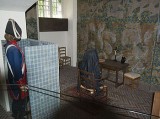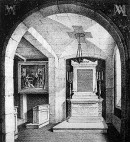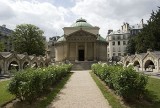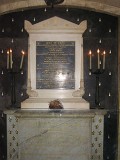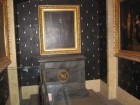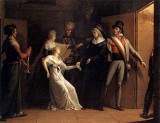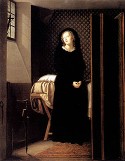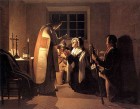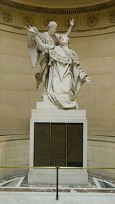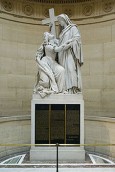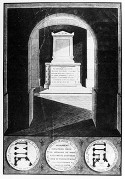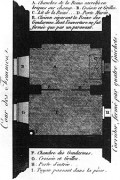The browser will either open the file, download it, or display a dialog.
After its restoration, the Conciergerie in Paris was reopened to the public in 1989, the year of the "Bicentenaire" celebrating the 200th anniversary of the French Revolution.[1] The new historical museum of the Conciergerie, formerly the most famous prison in France, offers visitors an almost authentic look at the conditions of living—or rather dying—during the revolutionary Terreur, the period of violence and mass executions that started in September 1793 and ended in July 1794 with the "Thermidorian Reaction." Visiting the Conciergerie today, one enters the gloomy atmosphere of 18th-century crime, grim with punishment and death, reminiscent of Madame Tussaud's Chamber of Horrors. Visitors are faced with life-sized figures of incarcerated men in small dark cells recalling some well-known and, in addition, thousands of nameless victims of the Terror. The representation of one of the most famous inmates of the Conciergerie is especially striking. Marie-Antoinette, Queen of France, spent the final two months of her life in this prison, before her execution on October 16th, 1793. Her figure, which can only be seen from behind, is shown sitting in a cell at a small wooden desk, guarded by a member of the National Guard (fig. 1). Contrary to its appearance, this scene is not set in the cell in which the queen was actually imprisoned, but is only meant to be an accurate reconstruction.[2] The cell in which Marie-Antoinette was imprisoned still exists, but not as a cell. In 1816, during the French Restoration era, it was transformed into a chapelle expiatoire—expiatory chapel (fig. 2). Unchanged during the Conciergerie's restoration before its reopening in 1989, it can still be visited within the prison complex. This small chapel that the newly restored Bourbon monarchy built in honor of Marie-Antoinette confronts the visitor with a staging of history that differs considerably from that of the reconstructed cell. Marie-Antoinette's chapelle expiatoire is in fact a true chapel. It consists of a very small room painted entirely in dark blue, a colored glass window reminding one of ordinary church windows, a cenotaph on one side of the room, and an altar on the other. Here we see the queen again, this time not "in person," but appearing on three paintings representing memorable events of her last days.
In the Conciergerie, the fate of Marie-Antoinette is therefore recalled in two very different ways. On the one hand, we are confronted with a setting that seems to be authentic when in fact it is not; on the other hand, the original queen's cell has been so radically changed that it no longer appears as an authentic historical site. The commemoration of the queen within the prison complex of the Conciergerie is hence somewhat contradictory: the lines between authenticity and historical falsity, between fact and fiction are not as clear as they seem to be at first glance. This deliberate delusion especially draws one's attention to the queen's expiatory chapel of 1816, which is the main subject of this article. This slightly kitsch memorial raises questions that not only concern the construction, political context, and iconography of the chapel, but also consider the notion of authenticity and the ways in which history has been staged and commemorated throughout the ages. Therefore, the focus of my article is twofold: first, I will put the queen's expiatory chapel in the political and cultural context of its creation and discuss its iconography and propaganda content. In doing so, I will also consider some other expiatory monuments of the Restoration era. Then, I will focus on the queen's chapel as a memorial and historical site. I will especially raise the question as to whether notions of authenticity had been accounted for by the authorities and artists who were involved in the chapel's construction. With this twofold approach I particularly want to broaden the art-history research perspective which until now has been focused on the iconography and political relevance of the Restoration's expiatory monuments.[3]
When concentrating on the monarchy's politics of remembrance, and studying its material results, (art)historical research is also concerned with questions of collective memory: what, why, and how do societies remember? Since Pierre Nora's "lieux de mémoire,"[4] the field of collective-memory studies has become more and more popular. The questions raised and answered in this field of research can increase our understanding of an epoch by focusing on its historical consciousness. In the final paragraphs of this article, I consider such questions, looking at the queen's chapel not only as a means of political propaganda, but also as a place that reveals a modern sense of history.
Remembering the Revolution in Restoration France
When, after the first (1814) and second (1815) downfalls of Napoleon, the Bourbons finally came back to France, they were confronted with one major issue: the political disunity among the French people. One may speak of two parties, or rather factions, in French politics at the time—liberals and royalists—but this would be an oversimplification of the political reality. While all in the left wing shared anti-royalist feelings, they were themselves divided into Bonapartists and Republicans. Those in the right wing welcomed the restoration of the monarchy; moderates among them hoped for a reformed, constitutional monarchy that would recognize the social and political changes the nation had gone through during the last twenty-five years, while the radical Ultra-Royalists dreamed of the glorious Ancien Régime.
The first Restoration king, Louis XVIII, brother of the executed Louis XVI, chose a moderate path, trying to avoid any provocation of the liberals and to strengthen the restored French monarchy. One part of his new political program consisted of the concept of "Oubli." This meant forgetting the nation's recent revolutionary and imperial past and, in particular, the political sympathies one shared before the restoration of the monarchy.[5] Liberals welcomed the Oubli, since it guaranteed they would neither be judged for their past wrongdoings, nor suppressed or discriminated against in the present. The future was open, never mind the past. The Ultra-Royalists, for their part, "refused to forget" as Stanley Mellon once pointedly stated.[6] They wanted to discuss what happened during the Revolution, the Consulate, and the Empire, and believed that the guilty needed to be found and punished. They based their call for remembering the past on the concepts of guilt and expiation and focused especially on the fate of the royal family. They were adamant that the executions of Louis XVI and Marie-Antoinette, the death of their son the Dauphin, and the tragedy of Madame Elisabeth, the king's sister, must never fall into such oblivion.[7]
Understandably, the newly restored monarchy could not ignore the royal victims of the Revolution. Commemoration was necessary—not only out of "respect" for their own dynasty, but also to pay deference to the European Allies who had helped the Bourbons to retake the French throne from Napoleon. Struggling between the two necessities of oblivion and remembrance, Louis XVIII found a compromise. According to the terms of a law enacted on January 19, 1816, it was decided that January 21, the anniversary of the death of Louis XVI, be declared a national holiday and that a national monument in memory of the royal victims of the Revolution be erected in Paris.[8] Louis XVIII's royal ordinance of February 14, 1816, further determined the royal house's official politics of remembrance, specifying that this monument was to be built in the new church of the Madeleine. Furthermore, three equestrian statues of former French monarchs that had been destroyed during the Revolution were to be reconstructed, including that of Louis XV in the square named after him, today's Place de la Concorde.[9] This latter decision was of special importance. The Place de Louis XV was not only an imposing location for a monument, but also a highly symbolic square since it was there where the king and queen had been guillotined in 1793. Therefore, it was the Ultra-Royalists' favored spot for an expiatory monument in honor of the executed royal couple.[10] Louis XVIII's decision to reconstruct the original equestrian sculpture, however, implied that there would never be such a memorial on the—from the royalist's point of view—historical "crime scene." Instead, expiatory monuments for Louis XVI, Marie-Antoinette, Madame Elisabeth, and the Dauphin were to be built in the enclosed space of the Madeleine church, which did not carry any significant symbolic or political meaning and was still under construction.[11]
The king's compromise recognized the desire to honor the royal victims of the Revolution, but to do so in the least provocative, and the least public, manner. His cautious politics of remembrance resulted from the tense political climate in France of which—Napoleon's Hundred Days had only come to an end in July 1815—he was painfully aware. Louis XVIII's sensitivity to the political battlefields in France, and his wish for national conciliation, distinguished him from his brother who, after Louis XVIII's death on September 16, 1824, succeeded him to the throne as King Charles X. Charles's right-wing political change-of-course was mirrored in his decision for an additional expiatory monument on the historical site of the regicide, the Place de Louis XV, in 1826.[12] This did not mean that he abandoned the project of a memorial in the Madeleine church, but it demonstrated a deliberate revision of his deceased brother's politics and was a conspicuous concession to the Ultra-Royalists. In the end, neither the monument in the Madeleine nor the one on the Place de Louis XV was completed, both being prevented by the outbreak of the July Revolution of 1830.[13]
While the two major monument projects of the royal house could never be finished, two other, much smaller and more intimate expiatory memorials were raised in Paris under the regime of Louis XVIII.[14] The expiatory chapel at the rue d'Anjou was built from 1816 to 1824 (fig. 3). It is located on the grounds of the former Madeleine Cemetery in which the executed royal couple had been buried in 1793.[15] The complex of this chapelle expiatoire consists of an entrance building, a courtyard, and the chapel itself; it is segregated from its surroundings by a small wall, therefore preserving the impression of a peaceful burial place and abandoning the declamatory gesture of public monuments. In fact, the chapel at the rue d'Anjou was not for the public; its construction was exclusively financed by the king and the Duchesse d'Angoulême (the daughter of Marie-Antoinette and Louis XVI) and it was built on the king's private property, as he had purchased the land comprising the former cemetery in 1816.[16] In contrast, the projected monuments in the Madeleine church and on the Place de Louis XV were being paid for by the state.[17]
The second expiatory monument which was built in Paris was Marie-Antoinette's chapel in the Conciergerie. The project for this monument had not been initiated by the king, but by the police minister, Élie Decazes and the préfet de la Seine, Comte de Chabrol, and financed by the ministry of police.[18] Nevertheless, being discretely hidden behind the walls of the Conciergerie, it did not corrupt King Louis XVIII's ideal of restrained commemoration. In fact, this chapel, which was begun and finished in 1816, does not seem to have attracted a great deal of attention from contemporaries[19] and is still little-known nowadays. It is, though, unique in two respects. First, it was then, and today still is, the last remaining historical site of the queen's captivity during the French Revolution. The first location of the royal family's imprisonment, the Tower of the former medieval fortress of the Knights Templar in Paris (the so-called "Tour du Temple"), had been demolished from 1809 to 1811.[20] Therefore, the Conciergerie was and is the only building that recalls this part of French history and the suffering of the royal family that has been depicted so often in counterrevolutionary paintings and graphics of the 1790s.
Second, Marie-Antoinette's chapel was dedicated to the queen alone and did not—contrary to most of the other projected expiatory monuments—focus on her husband's fate. The fact that the authorities decided in favor of an individual monument for Marie-Antoinette is significant. It reveals that the figure of the queen was meant to play an important role in royal Restoration era commemoration. One reason for that, I believe, can be found in the anti-royal propaganda of the late 18th century. Marie-Antoinette had been, as is well known, the most disliked and discredited member of the French royal family. There is no question that the aggressive revolutionary propaganda had focused especially on her. The queen was not only the "Autrichienne," offspring of the Austrian imperial family, and, therefore, seen as a foreigner and political enemy; she was regarded as a nymphomaniac pervert who not only fooled, but also manipulated her own husband, King Louis XVI; and ultimately she was "contra naturam," without any moral principles and virtue, only looking for personal satisfaction and living a life in superfluous luxury while the French people suffered from hunger.[21]
Against the background of these denunciations, Marie-Antoinette's expiatory chapel of 1816 can be considered an attempt to rehabilitate the former queen of France in a long-lasting, monumental way. The chapel shows a royal image of the queen as a loving, warm-hearted mother and wife and a faithful Christian, a direct counter-image to the ambitious and sexually perverted Marie-Antoinette of the Jacobins. This ideal conception of a virtuous queen had already been invented by the counter-revolutionary propaganda of the 1790s. Royalist painters, such as Jean-Jacques Hauer and Charles Bénazech, were significantly involved in the invention of this new counter-revolutionary iconography of the queen (and of the whole royal family, especially the king), which was, ironically, influenced by enlightenment ideals of bourgeois virtue, family values, and personal integrity. In response to the attacks of the revolutionaries, the royal family of France had therefore been transformed into something it had never been before: the intimate microcosm of a bourgeois family consisting of father, mother, and children.[22]
Royalists of the Restoration adopted this well-known counter-revolutionary image and put special emphasis on the religious, eschatological interpretation of the fate of the king and queen. Their deaths were interpreted as Christian martyrdom, and Louis XVI in particular, having pardoned his enemies in his testament and on the scaffold, was equated with Jesus Christ.[23] The iconography of Marie-Antoinette's expiatory chapel in the Conciergerie, which I will now discuss in more detail, well illustrates this kind of religious interpretation of the revolutionary past.
Marie-Antoinette, Heroine of History and Faithful Christian
Let us take a closer look at the interior decoration of Marie-Antoinette's expiatory chapel. It is linked to the Conciergerie's prison chapel by a small vestibule. The first thing we see as we enter the room is a cenotaph on a pedestal, with two inscriptions (fig. 4). One inscription, written in Latin in an accusatory manner, evokes the queen's fate during the French Revolution, stating that Marie-Antoinette had been sentenced to death by "the most criminal of all men."[24] In light of this accusation, the second inscription on the pedestal, which is written in French, gives the impression of a pacifying addendum. It is an excerpt from a letter Marie-Antoinette had written to her sister-in-law, Madame Elisabeth, some hours before her execution.[25] In 1816, the letter, surprisingly, was handed to the royal family by Edme-Bonaventure Courtois who had been member of the National Convention and had voted for the king's death in 1793.[26] After its disclosure, Marie-Antoinette's letter became one of the most important pillars of the royalist propaganda of the Restoration.[27] It attested to the queen's heroic bravery and loving tenderness in the face of death and recalled her husband, Louis XVI's pardon of his enemies, and equally offered her own forgiveness. On the pedestal, one can read:
Let my son never forget the last
words of his father that I repeat emphatically;
May he never seek to avenge our deaths.
I forgive all my enemies for the pain they have inflicted on me.
On the left of the chapel one can see a small altar onto which a monogram of Marie-Antoinette with a crown of thorns has been applied (fig. 5)—the queen's fate is compared with that of Jesus Christ. Three paintings on the walls surrounding the altar show Marie-Antoinette as prisoner of the Jacobins.[28] The way in which the three pictures have been arranged remind us of a triptych. Considering the sacred atmosphere of the room, the altar, and the crown of thorns, the scenes represented on the three paintings illustrate the last sufferings of Marie-Antoinette. The painting on the left, Les Adieux de Marie-Antoinette(1816; fig. 6),by Jacques-Auguste Pajou (1766–1828), shows the queen's farewell to her daughter and her sister-in-law on August 2, 1793, before her transfer from the Parisian "Tour du Temple," where the captive royal family had spent the past year, to the Conciergerie. The scene represents the beginning of Marie-Antoinette's isolated captivity. In Pajou's neo-classical painting we see her gripped firmly by a grim-looking member of the Paris Commune, taking leave of her fainted daughter who is being held by Madame Elisabeth. On the far left is a woman with a candle, maybe a servant; on the right, one can see, suggestively, another member of the Commune waiting in the door. In the center of the composition, the jailer connects the painting's dramatis personae.
The painting above the altar, Marie-Antoinette, après avoir reçus les secours de la religion (1816), by Gervais Simon,[29] shows Marie-Antoinette standing in her cell in the Conciergerie, praying or reflecting in front of a crucifix (fig. 7). In this devotional picture that Edme Miel described in 1817 as "simple and touching,"[30] the queen's fate and that of Jesus Christ are shown related to each other. Viewers are invited to reflect upon Marie-Antoinette's destiny as she reflects upon the destiny of the Savior. In Simon's picture, however, history is transformed into a sentimental melodrama, or rather anecdote, and apparently the painter took a great interest in the given surroundings, the interior decoration, and the supposed appearance of the queen's prison in 1793. With loving attention to detail, Simon shows the ancient floor of bricks, a small carpet, a room divider, an ordinary wooden camp bed, and a wallpaper with the fleur-de-lys, emblem of the Bourbons.
The picture on the right wall next to the altar, La Reine Marie-Antoinette communiant dans sa prison (1816; fig. 8), by Michel-Martin Drolling (1786–1851), shows the Last Communion of Marie-Antoinette. The painting is based on the following anecdote: the priest Magnin and a certain Mademoiselle Fouché (who may have been the priest's governess) had been secretly visiting the prisoners of the Conciergerie since 1792 to offer spiritual succor—a highly dangerous mission in those times of revolutionary terror. Both later claimed that they had also successfully entered Marie-Antoinette's cell where they celebrated Mass with the agreement of the queen's two guards. This event, which is represented in Drolling's painting, was publicized for the first time in 1815[31] and again in 1817 in an account by Charles-Louis de Sévelinges;[32] in 1824 the former priest, Lafont d'Aussonne, called it a "fabulous event."[33] Truth or Fiction? It seems rather unlikely that the Last Communion really took place.[34] Without going into detail, let us only say that if it had happened, it was most certainly not celebrated in the manner represented by Drolling: in front of the window with the priest wearing his liturgical vestment. Contrary to Pajou's Farewell of the Queen with its pathetic gestures, Drolling's Last Communion achieves pathos by a distinctive chiaroscuro. Marie-Antoinette looks longingly at the host shining miraculously in the priest's hand. The picture shows more than just a religious event—it demonstrates the ideas of divine revelation and salvation that the queen experiences during the ceremony.
The paintings are not uniform in style. Victor Hugo, who visited the chapel in 1846, remarked laconically: "You could see … on the walls two or three abominable paintings in which the bad style of the Empire fought against the bad taste of the Restoration."[35] In fact, the paintings manifest three different stylistic tendencies. Pajou's theatrical, stage-like composition of the Farewell of the Queen, with its clear arrangement of corresponding groups of people and the distinctive idealization of the protagonists, reflects the neo-classical education of the painter, who was born in 1766 and had been a student of the neo-classicist François-André Vincent and, quite possibly, of Jacques-Louis David.[36] Drolling, on the other hand, veers away from the rigid dogma of neo-classical stylization and theatricality and shows special interest in the effects of chiaroscuro as the carrier of meaning and atmosphere. As mirrored in his Last Communion, Drolling was affected by Italian Baroque painting when he studied as "pensioner" at the French Academy in Rome from 1811 to 1816.[37] Finally, Gervais Simon's peculiar style is striking. He does not portray a major historical event, but gives an anecdotal account of the queen's life in prison including the surrounding material world. Stylistically, we can assign him to the early 19th-century school of French troubadour painting, which depicted scenes of the middle ages and the early modern period in a very detailed manner. Troubadour painting attempted to generate a colorful and authentic image of the past by exactly describing historical sites, environments and clothing.[38] While the essential elements of the composition, architecture, and scenery are of considerable significance to the artistic impact, the depicted protagonists can only reflect or react: it is not they who heroically make history; they are subject to it. In Simon's picture, however, the promise of Christian salvation neutralizes historical fatality. Christian sentimentality and romantic melancholy go hand in hand.
The paintings' stylistic heterogeneity reflects the "coming-of-age" of the visual arts in the beginning of the 19th century; that is to say the evolution of artistic self-consciousness, self-reflexivity, and pictorial intertextuality. However, the iconography of the program is coherent, as is the iconography of the expiatory chapel as a whole. Looking back at the interior decoration, the propagandistic intent becomes quite evident. The royal victim of the Revolution is shown as a loving mother, brave heroine of history and, especially, faithful Christian. This kind of "sanctification" of Marie-Antoinette—and also of Louis XVI—in texts and images was common in Restoration France. The intent becomes particularly apparent in the two highly allegorized marble sculptures that dominate the expiatory chapel at the rue d'Anjou, a portrait of the king, (ca. 1830; fig. 9), by François-Joseph Bosio (1768–1845) and one of the queen (ca. 1830; fig. 10) by Jean-Pierre Cortot (1787–1843): the kneeling king, dressed in coronation robes and therefore appearing as a personification of the French monarchy, is accompanied by an angel who points heavenward with his left hand, signalizing the king's final ascension and Christian salvation. The queen, also kneeling, but wearing a rather simple, unadorned dress, is supported by the upright figure of Religion in whose hands she put herself. Additionally, Louis XVI's testament and Marie-Antoinette's letter to Madame Elisabeth are written on the respective pedestals of their marble figures.
While there exists some discrepancy between the artistic styles, genres, and sizes of the chapel at the rue d'Anjou and the one in the Conciergerie, both memorials basically share the same iconography. Both of them indicate that the king and queen had received Christian mercy. At the same time, they emphasize that the royal couple itself also provides spiritual succor and offers forgiveness: the last words of Marie-Antoinette and Louis XVI were, as quoted in both chapels, "je pardonne." The royal victims' pardon of their enemies was omnipresent in the Restoration's culture of remembrance. By highlighting that the royal couple had forgiven their enemies, memory could be eased, and national conciliation made possible. This Christian doctrine of "Grace" as a result became the second principle of Louis XVIII's political program, alongside "Oubli." As such, forgetting or repressing the memory of the revolutionary era and its protagonists must never mean that their victims fall into oblivion—but their commemoration should always draw upon the idea of Christian mercy.
Even though this official iconography of the royal couple was discreet and deliberate, it was not sufficient to reconcile the nation or to legitimize the monarchy. While the counter-revolutionary propaganda of the 1790s had preferred the image of a heroic, virtuous royal family, the iconography of the Restoration era demonstrated, from a liberal perspective, a fragile monarchy that was willing to make sacrifices and to passively accept its fate, contradicting, the enlightenment's idea of man and the concept of the bourgeois hero.[39] Furthermore, the image of a sanctified king and queen seemed to announce the return of the holy union of "Dieu et le Roi" at a time when anticlerical sentiments were widespread among the population.[40] And, finally, the general concept of "expiatory" monuments was problematic: officially defined as monuments built by a culprit in expiation of the regicide,[41] the question of who this culprit might be—the French nation? the revolutionaries?—or whether there was a culprit at all was one of the major issues in the contemporary debates on expiatory monuments.[42] Consequently, left-wing critics conceived these memorials as part of a counter-national propaganda of the Ultra-Royalists wanting to convict and discredit the nation as a whole.[43] In fact, this argument was justified to a certain degree since the two major monument projects—in the Madeleine church and on the Place de Louis XV—were supposed to be financed by the state and erected in the name of the nation, which, accordingly, was the culprit who had to expiate.[44]
Thus, emerging controversies regarding the meaning and design of expiatory monuments touched some major political issues of the Restoration era. Focusing solely on the monuments' iconography and political significance, however, does not account for their complexity as sites of remembrance. Memorials also demonstrate concepts and tendencies of contemporary approaches to, and representations of, history. In this regard, Marie-Antoinette's expiatory chapel is an extraordinary case study.
Radical Transformations: From Prison Cell to Chapel
In 1816 when police minister, Elie Decazes, and the prefect of the Seine department, Comte de Chabrol, decided to transform Marie-Antoinette's former cell into an expiatory chapel, they did not confine themselves to restoring the room or keeping it intact. The queen's cell was not only meant to be a memorial—it was intended to be what it became, a religious chapel. This transformation far exceeded the decoration of the room with just cenotaph, altar, and paintings. It was also altered architecturally: the original window aperture was enlarged and new colored windows were put in; the cell was vaulted; silver tears covered the dark blue painted walls; and its size was reduced drastically. One can trace the full alteration by means of a drawing (fig. 11) by its architect, Antoine-Marie Peyre (1770–1843).[45] This drawing, which was reproduced and made public[46], shows in its upper three-fourths a view of the chapel's cenotaph. Beneath it we see three "medals" (fig. 12). The central one bears an inscription naming the monument, its architect, and construction date.[47] The ones on the left and right are more important to us. The left medal shows the floor plan of the queen's cell in 1793, and the right one shows the floor plan in 1816 after its "restoration," as the inscription reads euphemistically. By comparing the two plans, one can quickly see what was changed. In 1793: the queen's cell is the one on top, consisting of two rooms separated only by two floor-to-ceiling partitions. Beneath it there is another narrow cell,[48] and at the bottom the actual prison chapel of the Conciergerie on a semicircular plan. In 1816: the upper part of Marie-Antoinette's cell is now completely separated from the lower part—the new expiatory chapel—by a wall. A small vestibule connects the queen's chapel with the prison chapel. Peyre also shows the location of the cenotaph in the former and the altar in the latter, which are both situated on the same axis. Obviously, the spatial connection of Marie-Antoinette's cell with the greater chapel of the prison was meant to reinforce the sacred atmosphere of the newly built memorial.[49]
One may wonder why the queen's cell, which had two parts only discretely separated from each other, was "halved," and why only the lower part became the actual expiatory chapel. According to C. F. L. Montjoye's Histoire de Marie-Antoinette which was published in Paris in 1797[50] and remains to this day one of the most important sources for the circumstances of the queen's imprisonment in the Conciergerie, the queen in fact only inhabited the lower part of the cell; her guards spent their time in the other half of the room.[51] Not being an eyewitness himself, the author claimed to have been informed by other witnesses.[52] He added a floor plan of the queen's cell to his account which shows the "Chambre de la Reine" and the "Chambre des Gendarmes," the room divider that separated the two, and the location of the queen's bed (fig. 13). Considering the historical facts, it becomes obvious that the radical alteration of the queen's cell and its reduction in size was not meant to transform it solely into a place of religious devotion, but also into a place free from painful memories: one must forget that the queen was guarded constantly, and that she was a prisoner waiting to be condemned and, finally, executed. One must only remember the woman who was mother and Christian until her death.
One can conclude, therefore, that Marie-Antoinette's former prison cell was changed for ideological purposes and that it lost its historical authenticity as a result of these changes. But at this point we are confronted with a paradox. Was it not the authenticity of the queen's cell that made it meaningful? In this room, Marie-Antoinette had actually suffered and prayed and written her last letter to her sister-in-law. The symbolic value of the cell resulted from its historical value. Accordingly, the French newspaper Le Moniteur Universel in an account on the chapel's inauguration highlighted its historical significance: the chapel had been built "in the very same room the royal victim inhabited during her detention," and the cenotaph had been erected "on the very same spot where the queen had presumably written her last and memorable letter to the Princess Elisabeth."[53] Peyre's drawing (fig. 12) also appreciates the authentic design of the cell and its importance as a place of remembrance by not only showing the floor plan of the newly constructed chapel of 1816, but also the original plan of 1793. While pointing out the historical relevance of Marie-Antoinette's prison cell, it seems that, at the same time, those responsible for the cell's transformation into a chapel did their utmost to destroy precisely this historical site or at least the historical traces that generated its meaning. Before discussing and maybe resolving this contradiction, let us take a closer look at the idea of "authenticity" and its alleged agent, the eyewitness, and their importance for historical awareness in Restoration France.
The Modern Quest for Authenticity: Eyewitnesses, Memoirs and the Royalist Cult of Remembrance in Restoration France
Nowadays, the eyewitness plays an important role in historiography and popular history. The eyewitness, with first-hand experience, supposedly has the capability not only to provide factual information on a specific event but also to give genuine and vivid insight into his experiences and to draw a colorful portrait of the past. This belief is questionable. Eyewitness testimonies are compromised by several factors, such as the limitations of sensory perception, the complexity of memory, and social and cultural imprints and conventions. Therefore, contemporary historiography is not only concerned with the question of whether a witness's testimony is accurate, but also—in a postmodern approach—whether objective testimony is possible at all, and whether something like "historic authenticity" really exists. However, in popular history there is a widespread assumption that eyewitness accounts revive the past in a striking and extraordinary manner. This modern understanding of historical authenticity and testimony is not a historical constant but emerged slowly in early modern times. In this complex history, the period of the French Revolution and its aftermath—including the Restoration era—is especially significant.[54]
The French Revolution apparently had an immense effect on the historical consciousness of the time. Through its drastic, violent, and unpredictable process, it helped to develop an understanding of history as a sequence of unique events, while at the same time questioning the idea that history has a meaning or is rationally explicable.[55] Since the Revolution was experienced as an outstanding event and a major turning point in history, contemporaries required more and more precise information: they were curious to know exactly what had happened, when and where; every detail could be of particular importance. Likewise, they were eager to share information and to take over the role of the eyewitness.[56] Their testimonies were published in contemporary newspapers and also in the form of small brochures or books and were part of the daily news coverage.
After Napoleon's downfall—twenty-five years after the storming of the Bastille— new interest was aroused in eyewitness accounts of revolutionary events. Of course, in Restoration France, these reports no longer met daily information needs; they were now regarded as historical sources and belonged to the literary genre of memoirs.[57] Not all of these " memoirs" can be perceived as autobiographies; many of them had the character of brief eyewitness accounts, being limited to a shorter phase of the author's life in which something extraordinary had happened.[58] During the Restoration, memoirs became an increasingly popular and significant way for historical narration and reflection. Different reasons can be given for this astounding popularity. After Napoleon's downfall, the interest in the Nation's history generally intensified, either out of curiosity, political calculation, or because looking back in history promised national self-assurance and identity. Memoirs responded to the growing public interest in the Revolution, and specifically in the victims' perspective, which finally, after the end of intense Napoleonic censorship, could be openly considered.[59] Large collections of memoirs concerning the time of Revolution were edited, for example the Collection des mémoires relatifs à la Révolution française published in the 1820s in 53 volumes.[60] It seems that contemporaries aimed for historical completeness—all obscurity should disappear, all gaps should be closed.
Eyewitness accounts of the 1790s as well as subsequently published memoirs of the Restoration era also satisfied the desire for historical authenticity. The term "authentic" or "authenticity" became significant as a commonly used catchphrase in the context of contemporary testimony,[61] referring to something being "genuine," "credible," "attested by witnesses," "approved" or even "canonical." Our present understanding of authenticity reaches far beyond this fundamental acceptation of the word, implying facets of meaning like "natural" and "direct," thus being linked to philosophical notions and discourses of the Enlightenment and of Romanticism. In the late eighteenth and nineteenth centuries, however, the meaning of "authentic" was based on the Greek and Latin as "genuine," indicating that the given account had actually been written by the person claiming to be its author, and had originated in the year as alleged; therefore, it is truthful.[62]
The history of the term "authentic" also helps one understand the concept of the figure of the eyewitness in late 18th- and early 19th-century France. Contemporary eyewitness accounts indicate that the witness to history took on the role of the authority who guaranteed "authenticity"; that is to say he verified history. The witness himself was fully aware of his significance: he perceived himself as important and considered it his duty to make his experiences public. This especially applied whenever he could tell of an extraordinary event that had happened secretly and only few people had witnessed; for example, the confinement of the royal family in Paris. A memoir considered as one of the most important sources for the circumstances of the royal family's captivity was the "Journal de ce qui s'est passé à la tour du Temple"by Jean-Baptise Hanet, called Cléry. Cléry, the dauphin's valet de chambre, followed the royal family into captivity in 1792. His Journal, published for the first time in 1798 in London, was a huge success in Europe.[63] In his foreword, Cléry particularly highlights his uniqueness and sole claim to historical truth: "Having been the only continual witness of the insults which the King and his Family were made to suffer, I alone can report and attest them with exactness."[64]
The eyewitness's awareness of being a unique "historical source" resulted in a specific literary style which seems meant to increase the credibility of his reports, which often have a formal character, similar to official accounts or certified documents, giving exact descriptions of objects, places and chronology.[65] Indeed, Cléry explains that he did not want to "compose" high-quality literature; his memoirs were meant to be source material for future historians.[66] Of course, contemporaries were fully aware that witnesses might be deliberately dishonest due to their political sympathies or for opportunistic reasons. But at the same time, they were epistemologically convinced that objective perception and representation were possible, and they believed in the concept of an "impeccable" witness who could report the historical facts as they had happened. This conviction lead to a high appreciation of eyewitness accounts as historical sources, and explains how memoirs could have become some kind of "historiographical principle"[67] in Restoration France.
Representations of History in Nineteenth-century France
It was and still is common to draw conclusions about authenticity based on outer appearance and formal criteria. In Restoration France, historical curiosity was inspired by this kind of "visible" authenticity that became manifest in appearances and material.[68] This enthusiasm for "true" history and the eyewitness as its mediator becomes apparent in, for instance, a review of a book by the eyewitness François Hüe published in Paris in 1814. The reviewer states:
Above all, nothing will amaze the attentive reader more than the accent of truth and sensibility that characterizes this script, historical monument of the highest interest … Here, everything bears the character of authenticity: everything is consistent with public and confirmed facts, and things we only know imperfectly will be explained with the aid of documents of an eyewitness who could neither misdirect us nor delude himself.[69]
Thus, history not only had to be authentic, it also had to look authentic; all kinds of historical sources and relics—including sites—were considered fascinating witnesses that seemed to have preserved history directly. Louis XVI's testament and Marie-Antoinette's letter to her sister-in-law, for example, were appreciated as such witnesses. During the Restoration, both manuscripts, which the king and the queen had written with their own hands, were often published as facsimiles.[70] Everyone now could have the "originals," whose material condition was of special interest since it allowed a sensual approach to the written text:
At the moment, it is not enough to discover the soul of an excellent prince, we also want to know the traits with which his hand has painted it, and we are impatient to possess the original of this precious Testament, sacred relic of a Martyr-King, presented … as facsimile, or as a perfect imitation.[71]
The quest for "authentic history" was part of a decidedly modern approach to the past, and marked the beginning of modern historiography as well as the development of an understanding of cultural heritage.[72] The notion of authenticity included two dimensions of historical consciousness: the scientific use of historical sources, and a sensual, emotional use of historical relics, which we might call the "antiquarian" approach to the past. With reference to Friedrich Nietzsche's categorization of approaches to history, Stephen Bann has demonstrated the antiquarian foundations of the romantic "cult of the past."[73] Eighteenth-century Antiquarians cultivated a devotional love for history and as such can be considered the ancestors of empathetic romanticism, as Bann claims. Romantic artists and writers, being inspired by the imaginative force of historical relics, developed a new dramatic and detail-loving way of historical representation. Gervais Simon's troubadour-style depiction of Marie-Antoinette can be cited as an example of this kind of antiquarian romanticism in painting (fig. 7). Hence, I would like to come full circle and return to Marie-Antoinette's expiatory chapel and the question of how to solve the contradiction between authenticity and politics.
Marie-Antoinette's Expiatory Chapel: Authenticity Behind the Staging
As we have seen, Marie-Antoinette's expiatory chapel was, on the one hand, meant to be part of the political propaganda of the Restoration era. Its decoration aims at an "image" of the queen that does not follow the rules of authenticity and historical truth, not least in the fact that its original architecture was destroyed. On the other hand, contemporaries were fully aware of the location's historical significance and symbolic meaning as a place of remembrance. Knowing the high regard in which memoirs and historical truth in Restoration France were held, the transformation of the queen's cell into a chapel appears even more contradictory. Therefore, I want to ask whether the desire for authentic history was taken into consideration when the queen's cell was transformed.
The rise of modern historical consciousness in 18th-century France became manifest in an understanding of history as being a single, coherent narrative that doesn't repeat itself. The desire to erect expiatory memorials primarily at the sites of unique historical events, consequently highlighting the significance of where history actually took place, attests to the contemporary appreciation of historical uniqueness and its protagonists' individual fates. As a result, the original form of Marie-Antoinette's former prison cell in the Conciergerie was destroyed, but it was not to be forgotten, as Peyre's drawing of the chapel indicates (fig. 12). He depicted not only the newly built monument, but also the genuine floor plan of the cell in 1793. His drawing shows the transformation of the site and therefore also allows the beholder to reconstruct the original cell in his mind. In situ, this mental reconstruction could be based upon tangible objects. There was one single conserved relic of the cell which was of great importance: the floor, distinctive due to its herringbone pattern (fig. 14). Montjoye's representation of the floor plan of the cell puts special emphasis on its pattern by showing and even naming it (fig. 13). His account of Marie-Antoinette's incarceration had been the contemporaries' main historical source, which might explain why the characteristic floor pattern is also represented, among others, in Peyre's (fig. 11), Simon's (fig. 7) and Drolling's (fig. 8) pictures. Being the sole empirically verifiable residue, the herringbone pattern was meant to guarantee the pictures' historical integrity. This becomes evident if one thinks about the paintings that were put in the expiatory chapel: the conserved floor which viewers can see and touch in reality is, at the same time, precisely depicted in Simon's and Drolling's paintings. Represented past and existing present overlap. Therefore, the pictures can authenticate the room by identifying it with the one in which the queen had prayed and suffered. In turn, reality can authenticate representation: the pictures may give the impression that they had been painted "on the spot."
At this point, the underlying idea of the chapel's interior decoration becomes clear. The authorities wanted the event to be visually represented where it had actually taken place; they aimed at an interplay of historical site and the depiction of history. In 1817, journalist and art critic Edme Miel claimed that the best way of vividly communicating historical knowledge would be through pictures, and he called for a prolific interaction of historical representations and monuments:
The best way to write the history of France, and the best way to engrave it into the memory and the heart of the French, is to paint it. But these national representations will only exert all of their influence if they are truly monumental, that is if they decorate the sites where the events have taken place.[74]
It is exactly the kind of "monumental painting" Miel had in mind that appeared in Marie-Antoinette's expiatory chapel: a pictorial historiography at the site of history. Here, pictures, historical traces, and the site itself equally serve as pillars of remembrance. Gervais Simon's detailed depiction of Marie-Antoinette's cell particularly serves this interpretation of a "monumental history painting." He presumably drew on Montjoye's account, showing all relevant objects mentioned in it, such as the room divider, bed and wallpaper. By contrast, Pajou and Drolling both concentrate on theatrical pathos and atmosphere. However, they, too, do try for historical truth. Most likely, both follow the same model for the queen's looks and garment: a portrait by Aleksander Kucharski (1741–1819)[75] showing Marie-Antoinette as widow and prisoner in the Temple, painted in 1793 (fig. 15). This often-copied and well-known picture was famous for being one of the last portraits the queen actually posed for.[76] Referring to the last "genuine" portrait of Marie-Antoinette, both Pajou's and Drolling's paintings are given a dimension of historical credibility that becomes even more significant by their particular surroundings.
A visitor to the Conciergerie in Paris today, comes across Marie-Antoinette not only once, but twice. On the one hand, there is a life-sized figure of the queen in a small room that attempts to provide a truthful reconstruction of the cell in which she was imprisoned in 1793 (fig. 1). On the other hand, Marie-Antoinette's fate is recalled through paintings hung in the cell that she actually inhabited until her execution and that had become an expiatory chapel in 1816. Thus, we are confronted with two different models of representation and transfer of historical knowledge. The first one reproduces the historical environment—it stages authenticity for educational (or entertainment) purposes. The expiatory chapel, on the contrary, aims at a heroic, Christian re-interpretation of actual events—it stages history for political purposes. Nietzsche called this interpretive approach to history "monumental": the past is glorified; its heroes are worth emulating.[77] But as we have seen, the expiatory chapel also recognizes the site's genuineness and historical meaning and allows—by way of pictures and (a few) relics—an "antiquarian"-scientific approach to history. Consequently, Marie-Antoinette's chapel in the Conciergerie is hard to define as to its mode of showing and communicating history: it oscillates between "monumental" and "antiquarian" approaches. Therefore, the chapel does not give a genuine impression, but it still permits one to recall what once was: authenticity is to be reconstructed in a discursive manner in which past and present are compared and connected with each other. In this process, the paintings take over the role of the chapel's tourist guide: through them the visitor can imagine the historical events that took place there.
It is, however, evident that authentic and symbolic content are not balanced—the desire for an idealized portrait of the queen and her fate clearly predominates in the chapel. Remembering the royal victims of the Revolution in Restoration France was more than just problematic; the legacy of the French Revolution played a significant role in the fervent political arguments of the time in which contemporaries struggled for nothing less than the identity of the French nation. While the Revolution wasn't openly discussed, its political and historical evaluation was the issue underlying most political debates.[78] To ease memory in a politically explosive time, the royal house followed a politics of remembrance in which some things remained unsaid and others were embellished. Thus, the original appearance and design of Marie-Antoinette's prison cell had been demolished and, consequently, history cannot be experienced directly any more. That demolition was criticized by contemporaries: "How much more touching and solemn this cell had been in its state of historical indigence!," the Comte de Robiano wrote in 1824.[79] Twenty-two years later, Victor Hugo visited the Conciergerie:
As we traverse a corridor, my guide stops me and shows me a small door … This was the door of Marie-Antoinette's cell, the only thing of her prison that had been conserved the way it was after it had been transformed into a chapel by Louis XVIII.[80] I contemplated this door with dolorous emotion. Through this door the queen went to the Revolutionary Tribunal; through there she went to the scaffold …
One moment later, I was in the chapel that had been the cell.
If you had seen there the naked pavement, the naked wall, the barred cellar window, the camp beds of the queen and the gendarme, and the historical room divider that separated them, that would have given a profound emotion and an inexpressible impression. You saw a small wooden altar that would have humiliated a village church, a painted wall (in yellow, of course), a window of a Turkish Café … The vaulted passage through which the queen went to the Tribunal had been blocked. There exists a respectful vandalism that is even more outrageous than the hate-filled vandalism because it's foolish. You didn't see anything any more that had been in front of the queen's eyes, if not a little of the pavement.[81]
Hugo's account exemplifies the historical consciousness of modern romanticism: he desires what Nietzsche would later call the "scent of mustiness"[82] that allows the beholder to empathize with history and gives an "inexpressible impression"—a subjective experience of remembrance that cannot be communicated through words. It is in fact impossible to have such an experience in Marie-Antoinette's expiatory chapel. Still, it would be wrong to contemplate the chapel only as a monument to serve propaganda. The authorities and artists involved at the time tried to reconcile politically motivated idealization with the authentic. As a result, the queen's chapel can be considered the predecessor of today's historical theme parks in which authenticity is the determinant of historical staging.
This paper is based on a chapter of my doctoral thesis entitled Topographie der Erinnerung: Die Sühnemonumente der französischen Restauration 1814–1830 (Berlin: Wissenschaftlicher Verlag Berlin, 2009). I would like to thank Volker Ferenz for his input and comments, and Isolin Fitzpatrick and Sara Ackermann for helping me with the translation of the text. All translations from French and German into English are my own.
[1] François Macé de Lépinay, "Conciergerie: La rénovation du Bicentenaire," Monuments historiques 162 (1989): 111.
[2] See Macé de Lépinay, "Conciergerie: La rénovation du Bicentenaire," 111, and François Macé de Lépinay and Jacques Charles, Marie-Antoinette: Du temple à la Conciergerie (Poitiers: Tallandier, 1989).
[3] The first monograph that solely dealt with the monarchy's expiatory monuments in Paris was published in 1981 by French historian Jean-Marie Darnis, who mainly gave a chronological account of their planning and realization. See Jean-Marie Darnis, Les monuments expiatoires du supplice de Louis XVI et de Marie-Antoinette sous l'Empire et la Restauration 1812–1830 (Paris: self-published, 1981). Later studies tend to focus on the close discussion and analysis of the iconography and construction of the monuments; see, for example, Michael Hesse, "Revolutionsopfer als Glaubensmärtyrer: Die Chapelle Expiatoire und die Sühnemonumente der Restauration in Paris," in Frankreich 1815–1830: Trauma oder Utopie? Die Gesellschaft der Restauration und das Erbe der Revolution, ed. Gudrun Gersmann and Hubertus Kohle (Stuttgart: Steiner, 1993), 197–216; Solange Granet, La place de la Concorde (Paris: Ministère de l'Education Nationale, 1963); and Marie-Claude Chaudonneret, "Le Mythe de la Révolution," in Aux armes et aux arts! Les arts de la Révolution 1789–1799, ed. Philippe Bordes and Régis Michel (Paris: Biro, 1988). Considering a broader view of the cultural politics of Restoration France, there are several important papers that help to understand this period in French history, for example, Sheryl Kroen, Politics and Theater: The Crisis of Legitimacy in Restoration France, 1815–1830 (Berkeley: University of California Press, 2000); and Natalie Scholz, Die imaginierte Restauration: Repräsentationen der Monarchie im Frankreich Ludwigs XVIII. (Darmstadt: Wissenschaftliche Buchgesellschaft, 2006). Both authors argue that the monarchy's weakness and failure in Restoration France were the outcome not only of wrong political decisions, but also of a failed policy of representation or image building. With regard to the monarchy's expiatory monuments. I agree with this thesis.
[4] The first volume included Nora's well-known and inspiring introduction to the topic: Pierre Nora, "Entre Mémoire et Histoire: La problématique des lieux," in Les lieux de mémoire, vol. 1: La République, ed. Pierre Nora (Paris: Gallimard, 1984), xvii–xlii.
[5] On the politics of Oubli see Scholz, Die imaginierte Restauration, 58–59, and T. Lawrence Larkin, "Louis XVIII's Cult[ural] Politics, 1815–1820," Aurora 5 (2004): 28–55. Article XI of the new Charte Constitutionnelle of 1814 prohibited all research of former political convictions. See Pierre Rosanvallon, La Monarchie impossible: Les Chartes de 1814 et de 1830(Paris: Fayard, 1994), 15–89.
[6] Stanley Mellon, The Political Uses of History: A Study of Historians in the French Restoration (Stanford: Stanford University Press, 1958), 80.
[7] See Gudrun Gersmann, "Der Schatten des toten Königs: Zur Debatte um die Régicides in der Restauration," in Gersmann and Kohle, Frankreich 1815–1830, 41–59. For more information about the Ultra-Royalists, see Jean-Jacques Oechslin, Le mouvement ultra-royaliste sous la Restauration: Son idéologie et son action politique(1814–1830) (Paris: Pichon & Durand-Auzias, 1960).
[8]Bulletin des Lois, 7th series, 2:77–78. The law was proposed by the King and adopted by the Chambre des Députés and the Chambre des Pairs. Discussions on the topic of how to remember adequately the Revolution's victims started in December 1815 in the two chambers. See Le Moniteur Universel, December 29, 1815 and January 10/12/18/19, 1816.
[9]Bulletin des Lois, 7th series, 2:180–81. This ordinance also determined that the Duc d'Enghien, a victim of Napoleon who had been executed in 1804, be honored in a separate memorial that was to be erected in the Sainte-Chapelle of the castle of Vincennes. For a closer discussion of this memorial see Anne-Marie de Lapparent, "Louis-Pierre Deseine: Statuaire, 1749–1822: Sa vie—son oeuvre" (PhD diss., Ecole du Louvre, 1985), 2:161–200; and Butenschön, Topographie der Erinnerung, 339–72.
[10] See Butenschön, Topographie der Erinnerung, 162–67.
[11] On the long building history of the Madeleine see Léon Gruel, La Madeleine depuis son établissement à la Ville l'Évêque: Étude historique et archéologique (Paris: Champion, 1910); and Gabriel Vauthier, Pierre Vignon et l'église de la Madeleine (Paris: Daupeley-Gouverneur, 1911).
[12] See Granet, Concorde; Solange Granet, "Le monument à Louis XVI de la Place de la Concorde," La Revue des Arts 6 (1956): 238–40; and Butenschön, Topographie der Erinnerung, 228–55.
[13] See Butenschön, Topographie der Erinnerung, 186–90 and 228–55.
[14] The aforementioned monument for the duc d'Enghien in Vincennes (which was actually a tomb), designed by the sculptor Louis-Pierre Deseine, was also completed before the outbreak of the Revolution of 1830; it was inaugurated in 1824.
[15] Regarding the cemetery of the Madeleine and the construction and iconography of the chapel, see André Vaquier, "Le cimetière de la Madeleine et le sieur Descloseaux," Paris et Ile-de-France 12 (1961): 97–134; Gudrun Gersmann, "Saint-Denis und der Totenkult der Restauration: Von der Rückeroberung eines königlichen Erinnerungsortes," in Kulturelles Gedächtnis und interkulturelle Rezeption im europäischen Kontext, ed. Eva Dewes and Sandra Duhem (Berlin: Akademie-Verlag, 2008), 139–58; Vassiliki Petridou, "P.-F.-L. Fontaine et L. H. Lebas: Une double paternité pour la Chapelle expiatoire à la mémoire de Louis XVI et de Marie-Antoinette," in Le livre et l'art: Etudes offertes en hommage à Pierre Lelièvre,ed. Thérèse Kleindienst (Paris: Somogy, 2000), 417–28; Hesse, "Revolutionsopfer als Glaubensmärtyrer"; and Butenschön, Topographie der Erinnerung, 256–99. In January 1815, the bodies of Louis XVI and Marie-Antoinette were exhumed and, three days later, on January 21, buried in the royal necropolis at the Basilica of Saint Denis.
[16] See Vaquier, "Le cimetière de la Madeleine," 130–31, and Butenschön, Topographie der Erinnerung, 283 and 298–99.
[17] See Bulletin des Lois, 7th series, 2:77–78, and Bulletin des Lois,1826, number 3083.
[18] See Darnis, Les monuments expiatoires, 59–64; and Macé de Lépinay and Charles, Marie-Antoinette,74–75. The chapel was built in agreement with the Conseil des Prisons.
[19] Most debates focused on the monument projects in the Madeleine church and on the place de Louis XV. Butenschön, Topographie der Erinnerung, 162–67.
[20] Henri de Curzon, La Maison du Temple de Paris: Histoire et Description (Paris: Librairie Hachette et Cie, 1888), 126–27.
[21] See Marguerite Jallut, "Quelques précisions sur l'abondante iconographie de Marie-Antoinette," La Revue des Arts 5 (1955): 11–20; Chantal Thomas, La Reine scélérate: Marie-Antoinette dans les Pamphlets (Paris: Editions du Seuil, 1989); Lynn Hunt, The Family Romance of the French Revolution (Berkeley: University of California Press, 1992), 89–123; and Antoine de Baecque, La caricature révolutionnaire (Paris: CNRS, 1988).
[22] On the royal visual propaganda of the 1790s see Evelyne Lever, "Le testament de Louis XVI et la propagande royaliste par l'image pendant la Révolution et l'Empire," Gazette des Beaux-Arts 94(1979): 159–73; Jean-Marie Bruson, "Bénazech, Hauer, Kucharski et quelques autres: Les peintres des derniers moments de la famille royale," in La famille royale à Paris: De l'histoire à la légende, exh. cat. Paris: Musée Carnavalet (Paris: Paris-Musées, 1993), 125–42; Alexandra K. Wettlaufer, "Absent Fathers, Martyred Mothers: Domestic Drama and (Royal) Family Values in A Graphic History of Louis the Sixteenth," Eighteenth Century Life 23, no. 3 (1999): 1–37; and Claude Langlois, Lacaricature contre-révolutionnaire (Paris: CNRS, 1988).
[23] See Martin Papenheim, "Les oraisons funèbres de Louis XVI et Marie-Antoinette des Années 1814–15–16: La rhétorique expiatoire," in Saint-Denis ou Le jugement dernier des rois, ed. Roger Bourderon (La Garenne-Colombes: Editions de l'Espace Européen, 1992), 315–23; Hesse, "Revolutionsopfer als Glaubensmärtyrer"; and Larkin, "Louis XVIII's Cult[ural] Politics." For information about Louis XVI's testament, see Lever, "Le testament de Louis XVI," 159–61.
[24] This quite long inscription on the cenotaph was quoted by the Journal des Débats on October 13, 1816 in both Latin and French.
[25] See Gosselin Lenôtre, La captivité et la mort de Marie-Antoinette: Les Feuillants - Le Temple - La Conciergerie; D'après des relations de témoins oculaires et des documents inédits (Paris: Perrin, 1897), 380–93.
[26] Courtois, as he himself claimed, had acquired the letter after Robespierre's death. As a former regicide who had followed Napoleon during the Hundred Days, Courtois was threatened by banishment in the beginning of 1816—a good time to present a relic of the former queen. See Lenôtre, La captivité et la mort de Marie-Antoinette, 380–93. Concerning the new law of amnesty see Raymond Huard, "Les conventionnels 'régicides' après 1815: aperçu historiographique et données historiques," in Bourderon, Saint-Denis, 283–99; and Gersmann, "Der Schatten des toten Königs."
[27] Lenôtre, La captivité et la mort de Marie-Antoinette, 393. On February 22, 1816, the letter was, by order of the king, read out to the Chamber of Deputies by police minister Élie Decazes.
[28] The paintings by Pajou and Drolling were not installed until 1817. See Le Moniteur Universel, October 17, 1816, and Joseph-Aimable Grégoire, Itinéraire de l'artiste et de l'étranger dans les églises de Paris, ou état des objets d'arts commandés, depuis 1816 jusqu'en 1830, par l'administration de cette ville (Paris: self-published, 1833), 62–63.
[29]Gervais Simon is not well-known; there is no entry on him in any of the notable art dictionaries such as The Grove Dictionary of Art.
[30] Edme F. A. M. Miel, Essai sur les Beaux-Arts, et particulièrement sur le salon de 1817, ou examen critique des principaux ouvrages d'art exposés dans le cours de cette année (Paris: Pélicier, 1817), 287. The painting could be seen in the Parisian Salon of 1817.
[31] In 1815, Antoine-Joseph Raup de Baptestin de Moulières published a letter written by the Princesse de Chimay in which she gave an account of the queen's Last Communion. A.-J. R de B. de Moulières, Le roi martyr, ou esquisse du portrait de Louis XVI (Paris: A. Eymery, 1815).
[32] Charles-Louis de Sévelinges, ed., Histoire de la captivité de Louis XVI et de la famille royale, tant à la tour du Temple qu'à la Conciergerie, comprenant le Journal de Cléry (Paris: L.-G. Michaud, 1817), 267–74. As editor of this edition of Cléry's Journal, Sévelinges refered to the queen's Communion in a long footnote.
[33] L. Lafont d'Aussonne, preface to La fausse communion de la Reine, soutenue au moyen d'un faux (Paris: Pichard, 1824). In 1824 and 1825, Lafont d'Aussonne published a total of three writings in which he accused Magnin and Fouché of fraud.
[34] See Lenôtre, La captivité et la mort de Marie-Antoinette, 292–307; Macé de Lépinay and Charles, Marie-Antoinette, 86–90.
[35] Victor Hugo, Choses vues: Souvenirs, journaux, cahiers 1830–1885; Texte présenté, établi et annoté par Hubert Juin avec des révisions pour la présente édition (Paris: Gallimard, 2002), 254.
[36] See Philippe Nusbaumer's study on Pajou: Jacques-Augustin-Cathérine Pajou 1766–1828: Peintre d'histoire et de portrait (Le Pecq-sur-Seine: self-published, 1997), and Robert Rosenblum's fundamental work on neo-classical painting: Transformations in Late Eighteenth Century Art (Princeton: University Press, 1967).
[37] He was especially inspired by Caravaggio's work. See some letters he wrote to his father in 1816, quoted in Valentine de Chillaz, Musée du Louvre, Département des arts graphiques, Inventaire général des autographes (Paris: Réunion des Musées Nationaux, 1997), 141.
[38] See Marie-Claude Chaudonneret, Fleury Richard et Pierre Révoil: La Peinture Troubadour (Paris: Arthena, 1980), and Beth S. Wright, Painting and History During the French Restoration: Abandoned by the Past (Cambridge: Cambridge University Press, 1997), 31–76.
[39] See, for example, Alexandre Corréard's criticism of a portrait of Louis XVI by Jean-Pierre Cortot: "Examen des projets présentés au concours, sur les embellissemens de la place Louis XVI," Journal du Génie civil, des sciences et des arts 4 (1829): 356–57.
[40] Regarding this problem see Kroen, Politics and Theater,and Bettina Frederking, "'Les funérailles de la monarchie' ou 'l'impossible oubli'," in Représentation et pouvoir: La politique symbolique en France (1789–1830),ed. Natalie Scholz and Christina Schröer (Rennes: Presses Universitaires de Rennes, 2007), 213–33.
[41] According to the law of January 19, 1816, these monuments were to be built "en expiation du crime de ce malheureux jour." Bulletin des Lois, 7th series, 2:77–78.
[42] See Butenschön, Topographie der Erinnerung, 154–58.
[43] Ibid., 17–21 and 154–58; Mellon, Political Uses, 30; see especially the contemporary essay "Union et oubli," La Minerve française 1 (1818): 190–91. This essay was published anonymously.
[44] "il sera élevé, au nom et aux frais de la Nation … un monument." Bulletin des Lois, 7th series, 2:77–78.
[45] Peyre was appointed official architect of the Palais de Justice in 1809. He was responsible for the restoration of the palace including the Conciergerie.
[46] See Darnis, Les monuments expiatoires, 147–49.
[47] The construction date is recorded as the 21st year of King Louis XVIII's reign. The inscription reads: Monument expiatoire érigé en mémoire de Marie Antoinette d'Autriche Reine de France et de Nav. à la Conciergerie du Palais de Justice. Peyre neveu architecte. L'an XXI dU Règne de Louis XVIII le Désiré Roi de France et de Navarre.
[48] It is often believed that this room had been Robespierre's prison cell; this cannot be confirmed. See Macé de Lépinay and Charles, Marie-Antoinette,73.
[49] See Antoine Marie Peyre, "Rapport à M. le Comte de Chabrol, Préfet du département de la Seine, sur les constructions et améliorations faites au Palais de Justice pendant son administration," Journal du Génie civil, des sciences et des arts 1 (1828): 73. As Michael Hesse has pointed out, the central apse of French churches, just behind the main altar, had been traditionally consecrated to the Virgin Mary. Hesse, "Revolutionsopfer als Glaubensmärtyrer," 212–13.
[50] C. F. L. Montjoye, Histoire de Marie-Antoinette-Josephe-Jeanne de Lorraine, archiduchesse d'Autriche, reine de France (Paris: Perronneau, 1797).
[51] Ibid., 464–65.
[52] Ibid., xvii–xviii.
[53]Le Moniteur Universel, October 17, 1816.
[54] Regarding the history of the eyewitness see Andrea Frisch, The Invention of the Eyewitness: Witnessing and Testimony in Early Modern France (Chapel Hill: University of North Carolina Press, 2004).
[55] See Reinhart Koselleck, "Historia Magistra Vitae: Über die Auflösung des Topos im Horizont neuzeitlich bewegter Geschichte," in Reinhart Koselleck, Vergangene Zukunft: Zur Semantik geschichtlicher Zeiten (Frankfurt am Main: Suhrkamp, 1979), 38–66. Cf.Dominique Poulot, "Surveiller et s'instruire": la Révolution française et l'intelligence de l'héritage historique (Oxford: Voltaire Foundation, 1996).
[56] Butenschön, Topographie der Erinnerung, 92–93, 102–9 and 112–19. One of the most famous eyewitnesses of the French Revolution was Madame Tussaud. See Kate Berridge, Madame Tussaud: A Life in Wax (New York: Morrow, 2006).
[57] See Fred E. Schrader, "Revolutions- und Emigrationsmemoiren in der Restauration: ein mentalitätsgeschichtliches Korpus," in Gersmann and Kohle, Frankreich 1815–1830, 29–40.
[58] See Alfred Fierro, Bibliographie critique des mémoires sur la Révolution écrits ou traduits en français (Paris: Service des Travaux Historiques de le Ville de Paris, 1989). The author lists 1502 memoirs that were published in the nineteenth and at the beginning of the twentieth century; his bibliography isn't exhaustive.
[59] Few memoirs of former revolutionaries or supporters of the Revolution were published. Many of the witnesses had been victims of the terror; others who had survived wouldn't give detailed accounts on their revolutionary careers. See Fierro, Bibliographie critique, 9–10.
[60] Edited by Baudouin Frères in Paris. See Mellon, Political Uses, 32; and Fierro, Bibliographie critique, 10.
[61] Eyewitness accounts of the 1790s frequently had titles such as "Détails authentiques" or "Récit authentique." See for example the contemporary accounts that have been gathered by Gaston Du Fresne, marquis de Beaucourt, Captivité et derniers moments de Louis XVI: Récits originaux et documents officiels (Paris: A. Picard et Fils), 1892.
[62] Regarding the concept and meaning of "authenticity," see, among others, Lionel Trilling, Sincerity and Authenticity (London: Oxford University Press, 1972); Eleonore Kalisch, "Aspekte einer Begriff- und Problemgeschichte von Authentizität und Darstellung," in Inszenierung von Authentizität,ed. Erika Fischer-Lichte and Isabel Pflug (Tübingen: Francke, 2000), 31–44; and Susanne Knaller, "Genealogie des ästhetischen Authentizitätsbegriffs," in Authentizität. Diskussion eines ästhetischen Begriffs,ed. Susanne Knaller and Harro Müller (Munich: Fink, 2006), 17–35.
[63] The first edition was entitled Journal de ce qui s'est passé à la tour du Temple pendant la captivité de Louis XVI, roi de France, par M. Cléry, valet de chambre du roi. See Fierro, Bibliographie critique, 111–12. For further information on eyewitness accounts dealing with the captivity of the royal family see Du Fresne, Captivité et derniers moments de Louis XVI, and Lenôtre, La captivité et la mort de Marie-Antoinette. Both authors discuss the question of which of the sources can be considered authentic.
[64]A journal of occurrences at the temple during the confinement of Louis XVI, King of France,By M. Cléry, the King's Valet-de-Chambre, Translated from the original Manuscript by R.C. Dallas, Esq. (London: Baylis, 1798), 2.
[65] Schrader, "Revolutions- und Emigrationsmemoiren," 30.
[66] Cléry [Jean-Baptiste Hanet], Journal de Cléry, suivi des Dernières heures de Louis XVI, par M. Edgeworth de Firmont, du récit des événements arrivés au Temple, par Mme Royale, fille du roi, et d'éclaircissements historiques tirés de divers mémoires du temps (Paris: Baudouin Frères, 1825), 1.
[67] Schrader, "Revolutions- und Emigrationsmemoiren," 29. This topic is further discussed in Butenschön, Topographie der Erinnerung, 124–34.
[68] See Poulot, Surveiller et s'instruire; and Stephen Bann, Romanticism and the Rise of History (New York: Twayne, 1995).
[69] Review of: François Hüe, Dernières années du Règne et de la Vie de Louis XVI (Paris: Imprimerie Royale, 1814). This book was published for the first time in 1806 in London. The cited review was published in Le Moniteur Universel on October 12, 1814. Hüe was Louis XVI's valet and had followed him into captivity in 1792.
[70] See Butenschön, Topographie der Erinnerung, 135–37.
[71]Fac simile du Testament de Louis XVI, Seule édition autorisée par son Excellence le Ministre de la police générale, comme conforme à celle faite sur l'original,Par L. E. Audot (Paris: Gueffier, n.d.), 2.
[72] Poulot, Surveiller et s'instruire. As Poulot demonstrates, the "antiquarian" respect for history was especially appreciated after Thermidor, being a direct reaction to the vandalism of the Revolution.
[73] Stephen Bann, "Clio in Part: On Antiquarianism and the Historical Fragment," in The Inventions of History: Essays in the Representation of the Past (Manchester: Manchester University Press, 1990), 100–121; Stephen Bann,"Views of the Past': Reflections on the Treatment of Historical Objects and Museums of History," in Inventions of History, 122–47; and Bann,Romanticism and the Rise of History. See also Poulot, Surveiller et s'instruire, 468. Nietzsche's categories are the "monumental," the "critical," and the "antiquarian" approaches, as argued in his essay entitled "Vom Nutzen und Nachteil der Historie für das Leben," published for the first time in 1874 as the second volume of his Unzeitgemässe Betrachtungen(Leipzig: Fritzsch).
[74] Miel, Essai, 270. Miel has in mind the pictorial decoration of the sacristy at Saint-Denis, once a prestigious project of Napoleon and finally accomplished during the Restoration.
[75] Also known as Alexandre Kucharski or Alexandre Kucharsky.
[76] See Bruson, "Bénazech, Hauer, Kucharski." I don't know of any other paintings that could have served as models for Drolling's and Pajou's representations of Marie-Antoinette.
[77] Friedrich Nietzsche, "Vom Nutzen und Nachteil der Historie für das Leben (1874)," in Unzeitgemässe Betrachtungen (Munich: Goldmann, 1992), 75–148.
[78] Gersmann and Kohle, Frankreich 1815–1830, 7–14.
[79] François, comte de Robiano, Marie-Antoinette à la Conciergerie, fragment historique publié par Le Comte Fr. de Robiano (Paris: Baudouin Frères, 1824), 88–89.
[80] This door actually still exists. It was sealed shut and walled up in 1793 and cannot be seen from within Marie-Antoinette's expiatory chapel. See Macé de Lépinay and Charles, Marie-Antoinette, 69–70.
[81] Hugo, Choses vues, 253–54.
[82] Nietzsche, "Vom Nutzen und Nachteil der Historie," 93.


